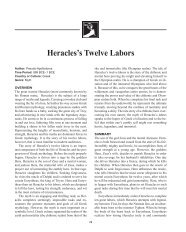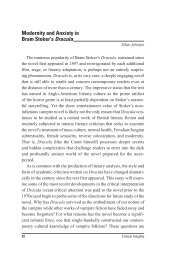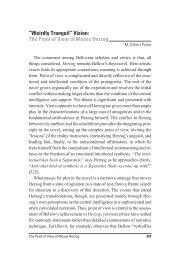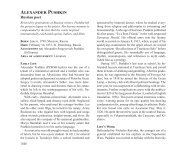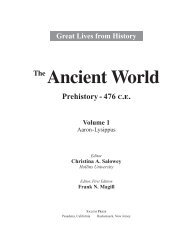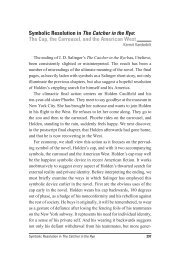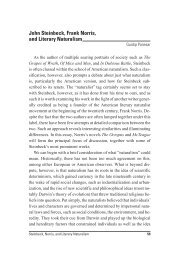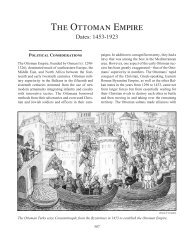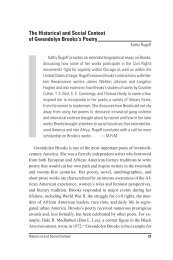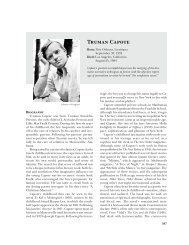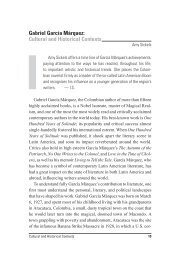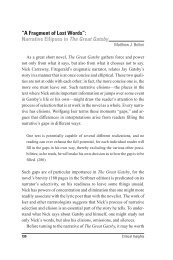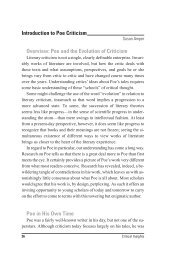You also want an ePaper? Increase the reach of your titles
YUMPU automatically turns print PDFs into web optimized ePapers that Google loves.
Critical Survey of Poetry Neruda, Pablo<br />
ple leave on their tools as they wear them down with the<br />
sweat of their hands. He would make poems like buildings,<br />
permeated with smoke and garlic and flooded inside<br />
and out with the air of men and women who seem<br />
always present. Neruda advocated an impure poetry<br />
whose subject might be hatred, love, ugliness, or beauty.<br />
He sought to bring verse back from the exclusive conclave<br />
of select minorities to the turmoil from which<br />
words draw their vitality.<br />
Crepusculario<br />
Neruda’s work is divided into three discernible periods,<br />
the turning points being the Spanish Civil War and<br />
his return to Chile in 1952 after three years of forced exile.<br />
During the first phase of his work, from 1923 to<br />
1936, Neruda published six rather experimental collections<br />
of verse in which he achieved the poetic strength<br />
that carried him through four more decades and more<br />
than twenty books. He published Crepusculario himself<br />
in 1923 while a student at the University of Santiago.<br />
Crepusculario is a cautious collection of poems reflecting<br />
his reading of French poetry. Like the Latin American<br />
Modernistas who preceded him, he consciously adhered<br />
to classical forms and sought the ephemeral<br />
effects of musicality and color. The poem that perhaps<br />
best captures the message indicated by the title of the<br />
book is very brief: “My soul is an empty carousel in the<br />
evening light.” All the poems in Crepusculario express<br />
Neruda’s ennui and reveal his experimentation with the<br />
secondary qualities of language, its potential for the effects<br />
of music, painting, and sculpture.<br />
There are several interesting indications of Neruda’s<br />
future development in Crepusculario that distinguish it<br />
from similar derivative works. Neruda eventually came<br />
to see poetry as work, a profession no less than carpentry,<br />
brick masonry, or politics; this conception of poetry<br />
is anticipated in the poem “Inicial,” in which he writes:<br />
“I have gone under Helios who watches me bleeding/ laboring<br />
in silence in my absent gardens.” Further, in<br />
Crepusculario, Neruda occasionally breaks logical barriers<br />
in a manner that anticipates much of his later Surrealistic<br />
verse: “I close and close my lips but in trembling<br />
roses/ my voice comes untied, like water in the fountain.”<br />
Nevertheless, Crepusculario is also characterized<br />
by a respect for tradition and a humorous familiarity<br />
with the sacred which Neruda later abandoned, only to<br />
rediscover them again in the third phase of his career, after<br />
1952: “And the ‘Our Father’ gets lost in the middle of<br />
the night/ runs naked across his green lands/ and trembling<br />
with pleasure dives into the sea.” Linked with this<br />
respect for his own traditions is an adulation of European<br />
culture, which he also abandoned in his second<br />
phase; Neruda did not, however, regain a regard for<br />
Western European culture in his mature years, rejecting<br />
it in favor of his own American authenticity: “When you<br />
are old, my darling (Ronsard has already told you) / you<br />
will recall the verses I spoke to you.”<br />
In Crepusculario, the first stirrings of Neruda’s particular<br />
contribution to Spanish poetry are evident—themes<br />
that in the early twentieth century were considered unpoetic,<br />
such as the ugliness of industrialized cities and<br />
the drudgery of bureaucracies. These intrusions of objective<br />
reality were the seeds from which his strongest<br />
poetry would grow; they reveal Neruda’s capacity to<br />
empathize with the material world and give it a voice.<br />
Twenty Love Poems and a Song of<br />
Despair<br />
One year after the publication of Crepusculario, the<br />
collection Twenty Love Poems and a Song of Despair<br />
appeared. It would become the most widely read collection<br />
of poems in the Spanish-speaking world. In it,<br />
Neruda charts the course of a love affair from passionate<br />
attraction to despair and indifference. In these poems,<br />
Neruda sees the whole world in terms of the beloved:<br />
The vastness of pine groves, the sound of beating wings,<br />
the slow interplay of lights, a solitary bell,<br />
the evening falling into your eyes, my darling, and in you<br />
the earth sings.<br />
Love shadows and timbres your voice in the dying echoing<br />
afternoon<br />
just as in those deep hours I have seen<br />
the field’s wheat bend in the mouth of the wind.<br />
Throughout these twenty poems, Neruda’s intensity and<br />
directness of statement universalize his private experiences,<br />
establishing another constant in his work: the effort<br />
to create a community of feeling through the expression<br />
of common, universal experience.<br />
Tentativa del hombre infinito<br />
In 1926, Neruda published Tentativa del hombre<br />
infinito (venture of infinite man), his most interesting<br />
2757



